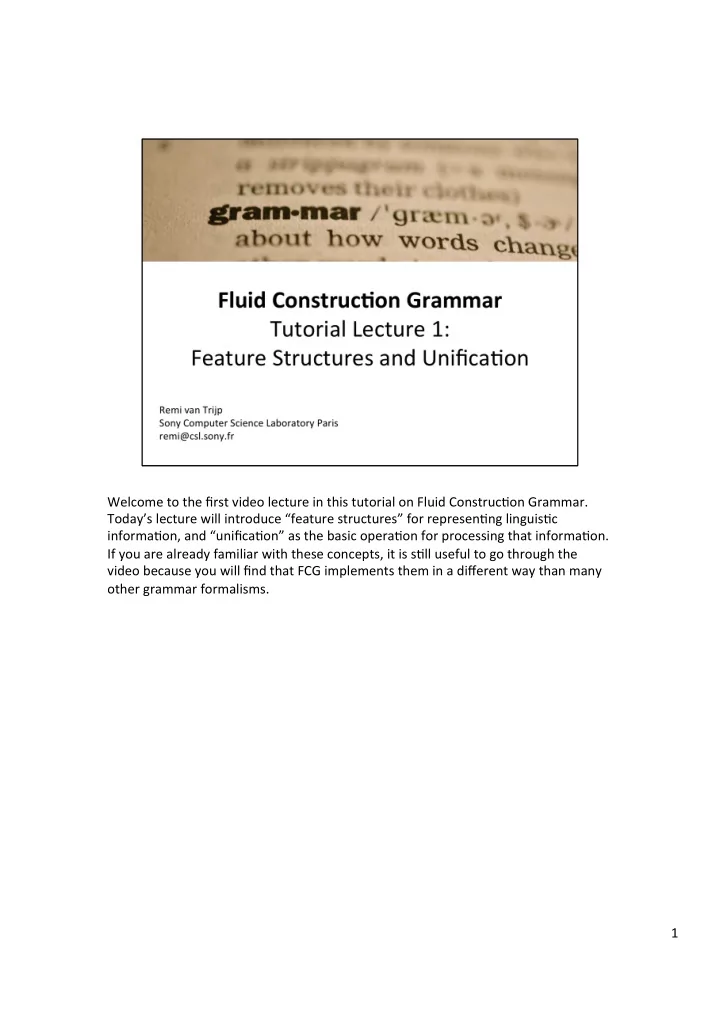

Welcome'to'the'first'video'lecture'in'this'tutorial'on'Fluid'Construc5on'Grammar.' Today’s'lecture'will'introduce'“feature'structures”'for'represen5ng'linguis5c' informa5on,'and'“unifica5on”'as'the'basic'opera5on'for'processing'that'informa5on.' If'you'are'already'familiar'with'these'concepts,'it'is's5ll'useful'to'go'through'the' video'because'you'will'find'that'FCG'implements'them'in'a'different'way'than'many' other'grammar'formalisms.' 1'
But'let’s'first'start'on'familiar'grounds.'Most'of'you'will'already'know'phrase' structure'grammars'or'contextJfree'grammars,'which'were'introduced'independently' of'each'other'by'Noam'Chomsky'for'linguis5cs'and'John'Backus'in'computer'science.' Here,'we'see'a'simple'phrase'structure'grammar'consis5ng'of'8'rewrite'rules'that' generates'four'different'sentences:'«'the'man'sleeps'»,'«'the'man'laughs'»,'«'the' woman'sleeps'»'and'«'the'woman'laughs'».' 2'
Of'course,'a'real'grammar'such'as'that'of'English'requires'much'more'rules.'Here,'we' already'see'a'slightly'more'elaborate'phrase'structure'grammar'that'is'not'only' capable'of'genera5ng'intransi5ve'uVerances'such'as'“the'man'sleeps”,'but'also'of' transi5ve'sentences'such'as'“the'woman'drew'the'picture.”'However,'the'grammar' also'generates'ungramma5cal'sentences'such'as'“the'man'sleeps'the'picture”.'So'the' problem'of'phrase'structure'grammars'is'that'they'are'too'powerful'and'quickly'start' to'overgenerate'as'soon'as'you'add'more'rules.' 3'
You'could'in'principle'solve'the'problem'of'overgenera5on'by'using'more'fineJ grained'categories'such'as'“intransi5ve'verb”'and'“transi5ve'verb”.'However,'when' wri5ng'a'realis5c'grammar,'the'inventory'of'categories'soon'explodes'and'we'lose'all' possible'generaliza5ons'that'exist'in'language.' 4'
This'problem'was'solved'a\er'a'major'breakthrough'was'achieved'in'computa5onal' linguis5cs'by'Mar5n'Kay,'who'formalized'the'tradi5onal'linguis5c'no5on'of'“feature' structures”.'Instead'of'trea5ng'categories'such'as'“verb”'and'“noun”'as'atomic'units,' you'can'treat'them'as'features'that'take'complex'values.' 5'
Here'is'an'example'of'how'the'sentence'“He'saw'her”'can'be'described'using' features'and'values.'Here'you'see'a'number'of'features'associated'with'sentences,' such'as'CAT'(category),'SUBJ'(subject),'DOBJ'(direct'object'and'so'on).'The'value'of' these'features'can'be'atoms,'as'is'the'case'for'CAT(egory),'but'it'can'be'a'feature' structure'as'well,'as'for'the'feature'SUBJ(ect),'which'further'breaks'down'into' features'like'GENDER,'CASE,'NUMBER'and'PERSON,'each'with'their'own'values.' 6'
In'Fluid'Construc5on'Grammar,'featureJvalue'pairs'are'represented'using'a'listJ nota5on.'Typically,'the'first'element'in'the'list'is'a'featureJname,'and'the'second' element'is'its'value.'Features'can'have'simple'values,'such'as'an'atom'or'a'set'or'a' list,'as'shown'here.'Values'can'also'be'featureJvalue'pairs'themselves,'as'shown'here.' Whenever'features'are'grouped'together,'they'are'also'represented'in'a'listJ nota5on.'This'is'why'you'see'the'addi5onal'bracket'here.' 7'
As'a'comparison,'you'can'see'the'list'nota5on'of'FCG'on'the'le\,'and'the'feature' structure'from'Mar5n'Kay’s'paper'on'the'right.'As'you'can'see,'the'mapping'between' the'two'representa5ons'is'quite'straighjorward.'Important'to'know'is'that'FCG,'just' like'Mar5n'Kay’s'original'grammar'formalism,'uses'UNTYPED'features.'This'means' that'you'do'not'need'to'do'anything'else'to'start'processing'these'featureJvalue' pairs.'In'TYPED'formalisms,'on'the'other'hand,'you'will'also'need'to'define'a'type' hierarchy.'In'the'next'few'weeks,'you'will'learn'why'Fluid'Construc5on'Grammar' does'not'use'types.' 8'
Now'we'come'to'the'ques5on'of'how'to'process'informa5on'represented'by'feature' structures.'The'basic'opera5on'that'FCG'uses'is'unifica5on.'If'you'already'know'other' formalisms,'you'will'probably'already'have'a'par5cular'defini5on'of'unifica5on'in' mind.'Unifica5on'is,'however,'a'concept'that'has'been'developed'in'many'different' disciplines,'and'each'disciplines'has'its'own'flavor.'I'can'recommend'Kevin'Knight’s' survey'if'you'want'to'learn'more'about'all'these'differences.'Abstractly'speaking,'the' unifica5on'problem'is'as'follows:'given'two'descrip5ons'X'and'Y,'can'we'find'an' object'Z'that'fits'both'descrip5ons?'In'most'grammar'formalisms,'this'becomes'“is' there'a'structure'z'which'subsumes'both'x'and'y”?'In'other'words,'most'unifica5onJ based'formalisms'implement'a'kind'of'unifica5on'that'combines'two'sources'of' informa5on'if'they'are'compa5ble'with'each'other.'But'that'is'not'the'only'possible' implementa5on'of'unifica5on.' 9'
In'Fluid'Construc5on'Grammar,'there'are'two'kinds'of'unifica5on'opera5ons'that'we' call'“match”'and'“merge”.'Match'corresponds'to'term'unifica5on,'which'Kevin'Knight' defines'as'follows:'given'two'terms'of'logic,'is'there'a'subs5tu5on'of'terms'for' variables'that'will'make'the'two'terms'iden5cal?'By'conven5on,'all'variables'that'we' use'start'with'ques5on'marks.'So'when'we'“match”'the'featureJvalue'pair'(number'? x)'with'(number'sg),'we'can'conclude'that'they'are'unifiable'because'we'can'find'a' subs5tu5on'for'the'variable'?x'that'makes'both'featureJvalue'pairs'iden5cal.' 10'
Here'are'some'examples'of'matching.' 11'
The'second'kind'of'unifica5on'that'we’ll'use'throughout'the'course'is'called'“merge”.' Merge'takes'two'structures'and'tries'to'combine'them'into'one.'Merging'is'more' lenient'than'matching'because'it'does'not'require'two'structures'to'be'iden5cal.'It' does,'however,'require'the'two'structures'to'be'compa5ble.' 12'
13'
Matching'and'merging'are'two'wellJdefined'opera5ons,'but'o\en'you'want'more' flexibility.'For'this'reason,'FCG'includes'several'special'operators'that'change'the' behavior'of'matching'and'merging.'One'of'them'is'called'the'“includes”Joperator,' which'does'not'check'for'an'iden5tyJrela5on'between'two'structures,'but'for'a' subsetJrela5on.' 14'
15'
16'
17'
18'
19'
20'
Recommend
More recommend